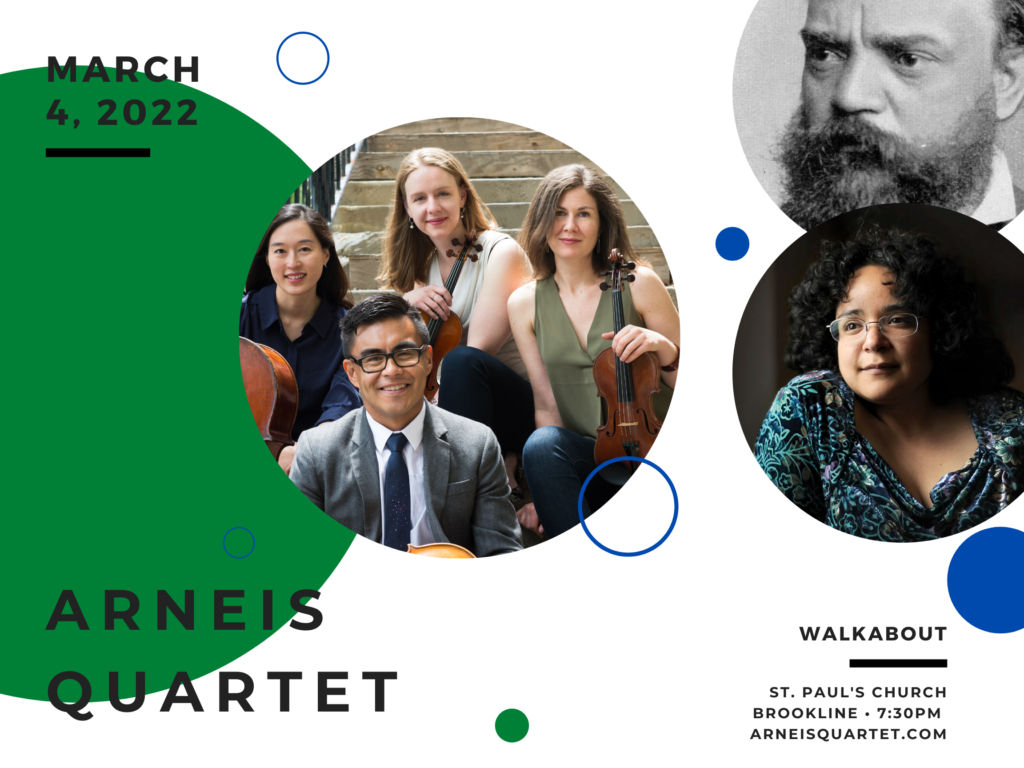
Financial support from donors is a key factor in helping Arneis achieve its artistic objectives. Please consider donating today! Arneis is a 501(c)(3) nonprofit organization and all donations are tax deductible.
Livestream
Program
Gabriela Lena Frank Leyendas: An Andean Walkabout (2001)
I. Toyos
II. Tarqueada
III. Himno de Zampoñas
IV. Chasqui
V. Canto de Velorio
VI. Coqueteos
Brief 10-minute intermission
Antonin Dvorak String Quartet in G major, Op. 106
Allegro moderato
Adagio ma non troppo
Molto vivace – Un poco più mosso
Andante sostenuto – Allegro con fuoco
Program Notes
I am thrilled that Arneis is finally performing Dvorak's G Major String Quartet Op 106 on March 4, 2022. For me, this is a twelve-year-dream come true.
The summer of 2010 was the first time I attended the Banff Chamber Music Residency in Canada with Rose, Dan and Agnes. We had been rehearsing together since the fall of 2009. Between September 2009 and June 2010, we had rehearsed a LOT, performed several concerts in Boston, completed a residency in Ohio and Michigan, sent recordings off to all kinds of potential residencies, summer music festivals and competitions, and lived together for seven days in one tiny hotel room in Times Square, while attending the Juilliard Quartet Seminar. I wanted to be a member of a real string quartet - for me, that was my utopia - and it was finally happening. We arrived at Banff, and I was feeling proud, accomplished, and fortunate. I had found my people.
The residency at Banff was three weeks long. By the end of this residency, I knew two things:
1. We had done so much in just ten months, but we had barely scratched the surface. We were real, we had ambition, and we were doing the work, but we had a lot more work to do. But - these were my people, and I was exactly where I wanted to be.
2. I adore Dvorak's G Major String Quartet. Specifically, I love listening to the Cecilia String Quartet play Dvorak G Major String Quartet - their performance in June 2010 was the first time I had heard or even knew about this piece. I was transfixed from the beginning to the end. Cecilia's stunning performance was a life-changing moment for me. For years afterwards, there were moments of that performance that stuck out in my mind - the beginning of the first movement, with the arpeggios in the first violin that sounded like the Bach g minor Presto, except this time in G Major! The beginning of the second movement - played by the cello, viola, and a second violin part that has a majestic power and beauty.
My first experience with Gabriela Lena Frank's string quartet Leyendas: An Andean Walkabout took place several years ago, in southwestern Vermont. I performed the fourth movement, Chasqui, as part of an educational outreach tour with Taconic Music, based in Manchester, VT. I loved performing this movement over and over again for hundreds of kids during that week - it has an amazing drive, energy, and thrill of depicting messengers running from village to village, through the Andes mountains. This past summer, we additionally learned and performed the first and sixth movements, as part of Taconic's summer festival, and I continued to be in awe of Frank's ability to create diverse and unique sound colors - a string quartet suddenly transforms into a panpipe (toyos, mvt 1), a bamboo flute (tarqueada, mvt 2), a chorus of mourning women (coro de mujeres, mvt 5), or a storm of guitars (vendaval de guitarra, mvt 6). The rhythmic energy and sound colors imitate at least five native Peruvian folk instruments throughout the entire work. I was increasingly eager to learn the other three movements, so I chose Frank's work to be paired with the Dvorak for this concert. Both Frank and Dvorak use traditional folk sounds and styles to create a unique compositional voice that helped propel them to become important and influential composers in their own time. Frank's mother is Peruvian of Chinese descent, and Frank dedicated this work to the Chiara Quartet and to her mother, "from whom I received the gift of Peru."
We started planning and discussing the Arneis 10th Anniversary Season in the spring of 2019. It would take place during the 2019-2020 concert season, and we would each curate a concert, choosing a piece we had already played but wanted to relearn and perform again, a piece that was recently written that we loved, and a standard repertoire piece that we hadn't done yet. For my concert, planned for April 2020, I didn't have to think very long about the new standard piece. I knew I wanted it to be Dvorak G Major. I had thought about this piece so much over the past decade, and the Cecilia Quartet's performance - it was time for Arneis to learn and perform it, so I could have new memories of it with my people. I was so excited for our concert scheduled on April 9, 2020.
The next part you all know. So here we are, twenty-three months later, and I finally get to perform this piece that I have mused over for twelve years, with my people.
-Heather Braun
Leyendas: An Andean Walkabout for string quartet draws inspiration from the idea of mestizaje as envisioned by the Peruvian writer José María Arguedas, where cultures can coexist without the subjugation of one by the other. As such, this piece mixes elements from the western classical and Andean folk music traditions.
"Toyos" depicts one of the most recognizable instruments of the Andes, the panpipe. One of the largest kinds is the breathy toyo which requires great stamina and lung power, and is often played in parallel fourths or fifths.
"Tarqueada" is a forceful and fast number featuring the tarka, a heavy wooden duct flute that is blown harshly in order to split the tone. Tarka ensembles typically also play in fourths and fifths.
"Himno de Zampoñas" features a particular type of panpipe ensemble that divides up melodies through a technique known as hocketing. The characteristic sound of the zampoña panpipe is that of a fundamental tone blown flatly so that overtones ring out on top, hence the unusual scoring of double stops in this movement.
"Chasqui" depicts a legendary figure from the Inca period, the chasqui runner, who sprinted great distances to deliver messages between towns separated from one another by the Andean peaks. The chasqui needed to travel light. Hence, I take artistic license to imagine his choice of instruments to be the charango, a high-pitched cousin of the guitar, and the lightweight bamboo quena flute, both of which are featured in this movement.
"Canto de Velorio" portrays another well-known Andean personality, a professional crying woman known as the llorona. Hired to render funeral rituals even sadder, the llorona is accompanied here by a second llorona and an additional chorus of mourning women (coro de mujeres). The chant Dies Irae is quoted as a reflection of the comfortable mix of Quechua Indian religious rites with those from Catholicism.
"Coqueteos" is a flirtatious love song sung by gallant men known as romanceros. As such, it is direct in its harmonic expression, bold, and festive. The romanceros sing in harmony with one another against a backdrop of guitars which I think of as a vendaval de guitarras ("storm of guitars").
— Gabriela Lena Frank
Antonín Dvořák was born at Nelahozeves, nr Kralupy on 8 September 1841 and died in Prague on 1 May 1904. He began the score of the quartet on 11 November 1895 and completed it on 9 December 1895. The piece was published as Dvořák’s Op. 106 in 1896 by Simrock. On 9 October 1896 the work was premiered in Prague by the Bohemian Quartet (violinists Karel Hoffman and Josef Suk, violist Oskar Nedbal, and cellist Hanuš Wihan).
In the manuscript score to his String Quartet in G major, Op. 106 Antonín Dvořák refers to the work as “the first composition after my second return from America”. His travels to America were prompted by Jeanette Thurber’s invitation for him to be artistic director and professor of composition at her National Conservatory of Music, whose mandate was, according to Michael B. Beckerman “... remarkably progressive: the most talented Americans, instead of following custom by going abroad to study with the great and near great, might now stay home and study at an excellent educational institution. Thurber’s notion of quality was not class-, race-, or gender-bound. The school was to be open to women, people of color, the handicapped, and the poor. Scholarships were available and all were encouraged to apply.” In addition to her educational mission Thurber was specifically interested in Dvořák because his music blended the international style established by German composers with the music of his Czech roots; she thought he would be the perfect teacher to help develop an American style of art music.
Many of Dvořák’s most well-known compositions come from his time in America, including his Symphony No. 9 in E minor, Op. 95 “From the New World”; String Quartet in F major, Op. 96 (“American”); and his Cello Concerto in B minor, Op. 104 (written for the same cellist that premiered the G major string quartet on this program!). Dvořák suffered from profound homesickness during this period. While the summer of 1893 spent at a Czech commune in Spillville, Iowa provided him some brief respite his decision not to return to America in 1895 brought him much happiness, and this is reflected in the mood of much of the G major string quartet.
Those familiar with the aforementioned works from his time in America will hear both similarities and departures from those works. The symphonic scale in the G major string quartet is more in line with the New World Symphony and Cello Concerto as opposed to the simplicity and compactness he favors in the “American” String Quartet. The illness of his sister-in-law Josefina Kaunitzova deeply influenced the composition of the Cello Concerto; her death in May 1895 led him to revise that piece to further highlight references to his song “Lasst mich allein” (“Leave Me Alone”), a favorite of hers. The second movement of the G major string quartet is widely regarded as one of his most moving funeral marches; perhaps Dvořák is still mourning the loss of his beloved sister-in-law in the midst of his feelings of joy resulting from the return to his homeland.
-Daniel Doña
This concert is made possible with support from

